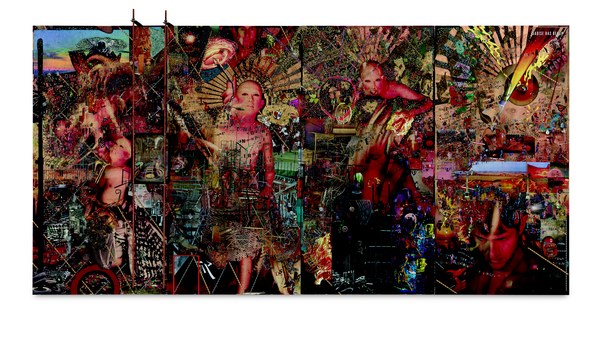The Broad Museum’s new exhibition, A Journey That Wasn’t, was assembled by curator Ed Schad with a view towards art that addresses the passing of time. Drawn from the Broad Museum’s own permanent collection, the show includes some 50 works, many of which do indeed bring our attention to the vagaries of history and the evanescence of experience. For example, the entrance gallery is dedicated to recent paintings by Ed Ruscha.
A pair of canvases from a 2007diptych, each nearly 28 feet in length, is not at all what most would expect of the artist, whose work most often includes words. One consists of diagonal rays of blue, red and green on a scuffed white background. White graffiti is scrawled across the bottom. On the opposite wall, those colored shards have collapsed as though of exhaustion. Titles are always important to Ruscha. These are called Azteca and Azteca in Decline.


Ed Ruscha, Azteca / Azteca in Decline, 2007, acrylic on canvas,
diptych, 48 x 330 in. (121.92 x 838.2 cm), The Broad Art Foundation
The Aztecs, the largest and most powerful society of the Americas for more than two hundred years, has been reduced to the stuff of legend since the 16th century. Implicit in these paintings is the notion that any dominant society, including our own, will eventually fade in importance and memory.
Predictably, the two large video installations in the show, both time-based media, exemplify the concept of the show. The title is derived from Pierre Huyghe’s 2006 A Journey That Wasn’t, the video of his putative exploration in Antarctica searching for a rare albino penguin. Mesmerizing scenes of icebergs, penguins, and explorers were later used as a performance staged in Central Park.

Pierre Huyghe, A Journey That Wasn't, 2006, Super 16 mm film and HD video transferred to HD video,
color, sound. The Broad Art Foundation. © 2018 Artists Rights Society (ARS), New York / ADAGP, Paris
The Visitors by Icelandic artist Ragnar Kjartansson, though popular with the public has not been on view since The Broad opened two years ago. It shows no signs of being less popular today with dozens of fans last Sunday enjoying the experience of a single song being played by different musicians, each in a separate room of an aging upstate New York mansion. In the background, the wallpaper peels, antiques are worn, but the aura of faded glory is ideal for the melodic strains of cello, piano or acoustic guitar, which is played by the artist as he lies in the water-filled bathtub.

Ragnar Kjartansson, The Visitors, 2012. Nine channel HD video projection, Commissioned by the Migros Museum für Gegenwartskunst, Zurich. The Broad Art Foundation. Photo by Elísabet Davids. © Ragnar Kjartansson
There are a number of other excellent works in the show, along with a few duds, but the point is that all were collected by Eli and Edye Broad, often in consultation with Joanne Heyler, now director of the museum.

Elliott Hundley, the high house low!, 2011. Wood, sound board, inkjet print on Kitakata, paper, pins, magnifying glass, photographs, plastic, metal. 99 x 192 1/2 x 18 in. (251.46 x 488.95 x 45.72 cm) The Broad Art Foundation © Elliott Hundley
Broad recently turned 85 and a visit to his namesake museum clarifies one indisputable fact. Broad has to be the single most important contributor to the cultural life of Los Angeles and has had an outsized impact on the revival of a previously moribund downtown district. Like most billionaires, he likes getting his own way. He is known for being outspoken, pushy, uncompromising and not great at sharing a spotlight. His autobiography is tellingly titled The Art of Being Unreasonable. Yet, this self-made businessman from Michigan was a crucial supporter of the Museum of Contemporary Art when it first opened in 1984 and came to the rescue a second time when it hit its financial crisis of 2009. He was critical to raising the money for Disney Hall when funding had dried up. After paying for the Broad wing at LACMA, he decideded that his 2000 plus art collection needed its own space and hired Diller Scofidio Renfro to design the building that has solidified Grand Avenue as the spine of a cultural center in just two years. Unlike most museums, admission is free apart from special exhibitions like the recent Jasper Johns survey. Broad has personally benefitted, of course. But at a time of griping and whining and backbiting about the role trustees play on museum boards in L.A., he deserves kudos. He may have done it his way but at least he got it done. His was far from being A Journey That Wasn’t. The show continues through early February, 2019. For more information, go to thebroad.org.
